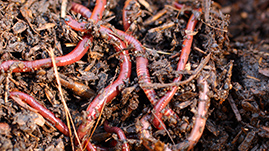Teachers' Domain - Digital Media for the Classroom and Professional Development
User: Preview



Location
Choosing the location of the backyard garden is a critical decision for its health. Since plants cannot move, they are limited to the benefits their location naturally offers, plus whatever the gardener can do to help them thrive.
A garden is part of an active habitat. Deer, raccoons, opossums, squirrels and some pets will consume garden plants. Planting near a flower garden attracts pollinators, while planting near a doghouse may attract a digger. Successful gardeners must understand the other participants in their garden’s habitat.
Natural conditions such as soil, sun, and weather determine the quality of life in an ecosystem. Knowledge of the needs of individual plants helps drive decisions. Some plants—like lettuce—thrive in partial shade. Others—hot peppers and tomatoes, for example—benefit from 8-10 hours of sunlight each day. Blueberries, like azaleas, prefer 50 percent shade and acidic soil. Some people prevent damage from frost, hail, or drought by planting in beds where a hoop house frame can be easily constructed. An understanding of local weather patterns, plant life cycles, and optimal growing conditions helps inform the decision regarding location.
Other considerations also should be taken into account in choosing the garden’s location. If the garden is easy to get to, that will contribute directly to its health. Sources of water, access to tools, and distance from the home or school should factor into the decision. Current and future plans for land use are also important. For example, choosing a school garden right next to the playground or future building site may literally stomp out chances for success.
A school or home garden can fit into a variety of settings, from large plots to raised beds to containers, each offering opportunities for learning and enjoyment and each demanding different levels of effort for success.
The Importance of Water
One of the most important considerations for garden locations is the proximity of water. To make sure water remains plentiful and unpolluted, gardeners follow sustainable practices like using rain barrels and drip irrigation; planting rain gardens; relying on rain gauges to determine if and when they need to water; and choosing native and other plants that are adapted to their region’s climate and growing conditions.
The role of water in plant health reveals much about photosynthesis, plant structure, and life cycles. The unique function of plants in making their own food depends upon regular access to water. The very structure of the plant from root to leaf allows for the entry, movement, and processing of water. Examining the importance of water to plants emphasizes the essential role of water to all life.
There are several ways that water supports life through plants. It holds up the plant and contributes to the plant’s structure. It is essential to photosynthesis and to the transport of glucose, the food created through photosynthesis, throughout the plant. It also is essential to the transport of nutrients like phosphorus from the soil and roots to the rest of the plant. And plants participate in the water cycle by using and releasing water molecules into the environment.
Soil Composition
Much of the health and success of a garden depends upon the soil. The roots of a plant work like a sponge soaking in water and nutrients from the soil. If the soil does not drain well, heavy rain will drown the plants. If the soil is compacted, plants will struggle to form roots. When nutrients are deficient in the soil, there are consequences for the plant. Luckily, there are several methods of preparing and enriching a garden’s soil that improve soil quality and the chance of success.
Scientists have identified 14 key plant growth nutrients in soil, including both macronutrients (those that are required in greater quantities) and micronutrients (those that are required only in smaller amounts).
Nitrogen (N), phosphorus (P), and potassium (K) are identified as primary macronutrients because they are often depleted in soils and need to be replenished for plants to thrive. The secondary macronutrients are calcium (Ca), magnesium (Mg), and sulfur (S). These chemical nutrients usually are present in large enough quantities that gardeners don’t need to add them to soil.
The most important micronutrients are boron (B), copper (Cu), iron (Fe), chloride (Cl), manganese (Mn), molybdenum (Mo), and zinc (Zn).
All soil is not the same. A soil test reveals what nutrients are present and which ones need to be added. Earthworms—which enrich and aerate soil as decomposers that break down dead or decaying matter—are another indicator of healthy soil.
One step that the gardener may take to improve soil quality is using compost. Potato peelings, coffee grounds, and eggshells are just a few of the items that can go into a compost pile. After several months of decomposition, compost turns into a rich, black material that looks like dirt. It can be added to soil before planting or placed around the plant as mulch. Either way, the soil is enriched.
 Loading Standards
Loading Standards